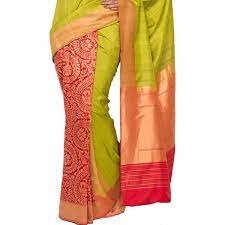Banarasi sarees are a traditional and luxurious garment that are popular in India and around the world. Made in the city of Varanasi, these sarees are known for their intricate designs and luxurious silk fabrics. However, as with any fine garment, it is important to properly care for your Banarasi saree to ensure that it stays in good condition.

Tips for maintaining your Banarasi saree:
1. Store your saree properly:
When not in use, it is important to store your Banarasi saree properly to prevent it from becoming damaged or soiled. Avoid storing your saree in damp or humid areas, as this can cause the fabric to become moldy or musty. Instead, store your saree in a cool, dry place, such as a closet or wardrobe. You can also consider using a garment bag or acid-free tissue paper to protect the saree from dust and other contaminants.
2. Handle your saree carefully:
Banarasi sarees are made of delicate silk, so it is important to handle them with care to prevent tearing or staining. Avoid pulling or tugging on the fabric, and be careful when draping the saree to avoid snagging it on sharp objects. When folding your saree, be sure to fold it along the natural creases to prevent wrinkles or creases.
3. Dry clean your saree:
It is generally best to have your Banarasi saree dry cleaned by a professional to ensure that it is properly cared for. Dry cleaning will remove dirt and stains from the fabric without causing shrinkage or discoloration. Avoid washing your Banarasi saree at home, as the harsh chemicals in detergents and the heat of a dryer can damage the silk fabric.
4. Repair any damage promptly:
If you notice any holes, tears, or other damage to your Banarasi saree, it is important to have it repaired promptly to prevent the damage from worsening. A professional seamstress or tailor can repair small holes or tears, or you can bring your saree to a dry cleaner for more extensive repairs.
5. Protect your saree from spills and stains:
To prevent spills and stains from ruining your Banarasi saree, it is a good idea to wear a protective underskirt or petticoat when wearing the saree. This will help to absorb any spills and protect the fabric from damage. If you do happen to spill something on your saree, act quickly to blot the stain with a clean, dry cloth. Avoid rubbing the stain, as this can cause it to spread or become more difficult to remove.
6. Avoid exposing your saree to sunlight:
Sunlight can fade or discolor the fabric of your Banarasi saree, so it is important to avoid exposing it to direct sunlight for extended periods of time. If you need to store your saree in a sunny location, consider using a garment bag or wrapping it in acid-free tissue paper to protect it from the sun’s harmful rays.
7. Store your saree correctly when traveling:
If you are planning to travel with your Banarasi saree, it is important to store it correctly to prevent it from becoming damaged or soiled. Avoid packing your saree in a suitcase with heavy items, as this can cause it to become wrinkled or creased. Instead, consider packing your saree in a garment bag or wrapping it in acid-free tissue paper to protect it during transit.
There are a few potential issues that can arise with Banarasi sarees:
1. Quality:
Some Banarasi sarees may be made with lower quality silk or have less intricate designs, which can affect their overall appearance and durability. It’s important to research the brand and look for reviews before purchasing a Banarasi saree to ensure that you are getting a high-quality product.
2. Price:
Banarasi sarees can be quite expensive, especially those made with high-quality silk and intricate designs. This may be a consideration for those on a budget.
3. Maintenance:
Banarasi sarees are made of silk, which can be delicate and prone to tearing or staining if not cared for properly. It’s important to follow the care instructions provided by the manufacturer to ensure that the saree stays in good condition.
4. Weight:
Some Banarasi sarees can be quite heavy, which can be uncomfortable to wear for extended periods of time. If you are planning to wear a Banarasi saree for a long event, it’s a good idea to try it on beforehand to make sure it is comfortable.
5. Complexity:
Banarasi sarees are known for their intricate designs and patterns, which can be complex and time-consuming to create. This can make the sarees more expensive and may also make them more difficult to match with other clothing or accessories.
Here are a few solutions to the potential problems with Banarasi sarees:
1. Quality:
To ensure that you are getting a high-quality Banarasi saree, it’s important to research the brand and look for reviews before purchasing. You can also ask for recommendations from friends or family members who have purchased Banarasi sarees in the past.
2. Price:
If the price of a Banarasi saree is a concern, you may want to consider purchasing a pre-owned saree or looking for sales or discounts. You can also consider purchasing a saree made with a less expensive fabric, such as cotton or chiffon, and dressing it up with a Banarasi-style border or embroidery.
3. Maintenance:
To care for your Banarasi saree properly, it’s important to follow the care instructions provided by the manufacturer. This may include hand-washing the saree or taking it to a professional cleaner. Avoid spilling liquids on the saree and storing it in a cool, dry place to prevent staining or damage.
4. Weight:
If you find a Banarasi saree to be too heavy, you may want to consider purchasing a saree made with a lighter fabric, such as chiffon or georgette. You can also ask the seller about the weight of the saree before purchasing it to make sure it is comfortable to wear.
5. Complexity:
If you are concerned about matching a Banarasi saree with other clothing or accessories, you may want to consider purchasing a saree with a simpler design or a more neutral color. You can also ask a stylist or fashion consultant for advice on how to pair the saree with other items in your wardrobe. Overall, it’s important to choose a saree that feels comfortable and suits your personal style.
Types of Banarasi Sarees
There are several types of Banarasi sarees, each with its own unique features and characteristics. Some of the most common types of Banarasi sarees include:
1. Tanchoi Banarasi sarees :
This type of Banarasi saree is known for its intricate patterns and designs, which are created by interweaving different colored silk threads. Tanchoi sarees are typically made with gold and silver threads and are often worn by brides or at formal events.
2. Cutwork Banarasi sarees :
Cutwork Banarasi sarees feature intricate cut-out designs in the fabric, which are often embellished with gold or silver embroidery. These sarees are known for their delicate and intricate appearance and are often worn at formal occasions.
3. Jangla Banarasi sarees :
Jangla Banarasi sarees are known for their vibrant colors and bold, geometric patterns. These sarees are often made with a blend of silk and cotton and are suitable for a variety of occasions.
4. Shimmer Banarasi sarees :
Shimmer Banarasi sarees are made with a special type of silk that has a subtle shimmer or sheen to it. These sarees are known for their luxurious appearance and are often worn at formal events or special occasions.
5. Organza Banarasi sarees :
Organza Banarasi sarees are made with a lightweight, transparent fabric that is known for its delicate, ethereal appearance. These sarees are often embellished with gold or silver embroidery and are suitable for formal events or special occasions.
6. Butidar Banarasi sarees :
Butidar Banarasi sarees are known for their intricate, floral designs, which are created by hand-weaving different colored silk threads. These sarees are often made with gold or silver threads and are suitable for formal events or special occasions.
7. Jamawar Banarasi sarees :
Jamawar Banarasi sarees are known for their luxurious fabrics and intricate designs, which are often embellished with gold or silver embroidery. These sarees are typically made with wool or silk and are suitable for formal events or special occasions.
8. Brocade Banarasi sarees :
Brocade Banarasi sarees are known for their rich, ornate patterns, which are created by weaving different colored silk threads together. These sarees are often made with gold or silver threads and are suitable for formal events or special occasions.
9. Sambalpuri Banarasi sarees :
Sambalpuri Banarasi sarees are made in the state of Odisha and are known for their intricate ikat patterns and bold, colorful designs. These sarees are typically made with silk and are suitable for a variety of occasions.
10. Tissue Banarasi sarees :
Tissue Banarasi sarees are made with a lightweight, transparent fabric that is known for its delicate, ethereal appearance. These sarees are often embellished with gold or silver embroidery and are suitable for formal events or special occasions.
11. Silk Banarasi sarees:
Silk Banarasi sarees are known for their luxurious, smooth fabric and intricate designs. These sarees are often made with gold or silver threads and are suitable for formal events or special occasions.
12. Satin Banarasi sarees:
Satin Banarasi sarees are known for their smooth, glossy finish and luxurious feel. These sarees are often made with silk or synthetic satin and are suitable for formal events or special occasions.
13. Georgette Banarasi sarees:
Georgette Banarasi sarees are made with a lightweight, sheer fabric that is known for its flowing, graceful drape. These sarees are often embellished with gold or silver embroidery and are suitable for formal events or special occasions.
14. Chiffon Banarasi sarees:
Chiffon Banarasi sarees are made with a lightweight, transparent fabric that is known for its delicate, ethereal appearance. These sarees are often embellished with gold or silver embroidery and are suitable for formal events or special occasions.
15. Embroidered Banarasi sarees:
Embroidered Banarasi sarees are known for their intricate, decorative embroidery, which is often created with gold or silver threads. These sarees are suitable for formal events or special occasions.
16. Zari Banarasi sarees:
Zari Banarasi sarees are known for their intricate, decorative embroidery, which is often created with gold or silver threads. These sarees are suitable for formal events or special occasions.
17. Zardosi Banarasi sarees:
Zardosi Banarasi sarees are known for their intricate, decorative embroidery, which is often created with gold or silver threads. These sarees are suitable for formal events or special occasions.
18. Kadhua Banarasi sarees:
Kadhua Banarasi sarees are known for their intricate, hand-woven designs, which are created by interweaving different colored silk threads. These sarees are often made with gold or silver threads and are suitable for formal events or special occasions.
Ultimately, the best type of Banarasi saree for you will depend on your personal style and the occasion you are dressing for. It’s always a good idea to try on a few different styles to see which one feels most comfortable and flattering.
